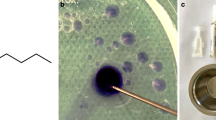Summary
Polymethyl methacrylate (PMMA) microspheres were used as an embolic agent to reduce the vascularity in eight patients with intracranial vascular tumours. Post embolization angiograms showed 30–60% reduction in the vascularity of the tumours. No patient developed any neurological complications in the immediate post-embolization period. These eight patients subsequently underwent surgery for the removal of their tumours. During surgery there was minimal blood loss and a good plane of cleavage was obtained between the tumour and the adjacent brain. The surgical specimens were examined histopathologically for the effects of PMMA. PMMA microspheres, in contrast to other cyano-acrylates — Isobutyl-2-cyano-acrylate (IBCA) — did not elicit either inflammatory reaction or mural angionecrosis within the wall of the embolised vessels. The histopathological studies suggest that PMMA microspheres are an inert material and can be used as an adjunct in the management of intracranial vascular tumours.
Similar content being viewed by others
References
Bernestein A, Kricheff I (1979) Catheter and material selection for transarterial embolization: technical consideration ii, Materials. Radiology 132: 631–639
Debrun G, Vincula P, Fex A, Drake CG (1982) Embolization of arteriovenous malformation with bucrylate. Experience in 46 cases. J Neurosurg 56: 615–627
Flandroy P, Grandfils C, Colligon J, Thibatute A, Nihant N, Barbette S, Jerome R, Teyssie PH (1990) (D.L) Polylactide microspheres as an embolic agent. A preliminary study. Neuroradiology 32: 311–315
Jayakrishnan A, Thanoo BC, Ratinam K, Ravimandalam K, Rao VRK (1989) Hydrogel microspheres from cross-linked ethylene glycol dimethacrylate. Synthesis and biocompatibility studies. Bull Material Sciences 12: 17–25
Merrill EW, Pekala RW, Mahmud NA (1987) Hydrogel for blood contact. In: Pappas N (ed) Hydrogels in medicine and pharmacy, Vol 3. CRC Press, Florida, pp 1–16
Ratner BD, Hoffman AS (1976) Synthetic hydrogel for biomedical application for medical and related application. In: Andrage JD (ed). ACS Press, Washington, pp 1–35
Vinters HV, Lundie MJ, Kaufmann JCE (1986) Long term pathological follow-up of cerebral arteriovenous malformation treated by embolization with bucrylate. N Engl J Med 314: 477–487
Author information
Authors and Affiliations
Rights and permissions
About this article
Cite this article
Radhakrishnan, V.V., Saraswathy, A., Rao, V.R.K. et al. Histopathological evaluation of polymethyl methacrylate as an embolic agent. Acta neurochir 117, 30–33 (1992). https://doi.org/10.1007/BF01400631
Issue Date:
DOI: https://doi.org/10.1007/BF01400631




